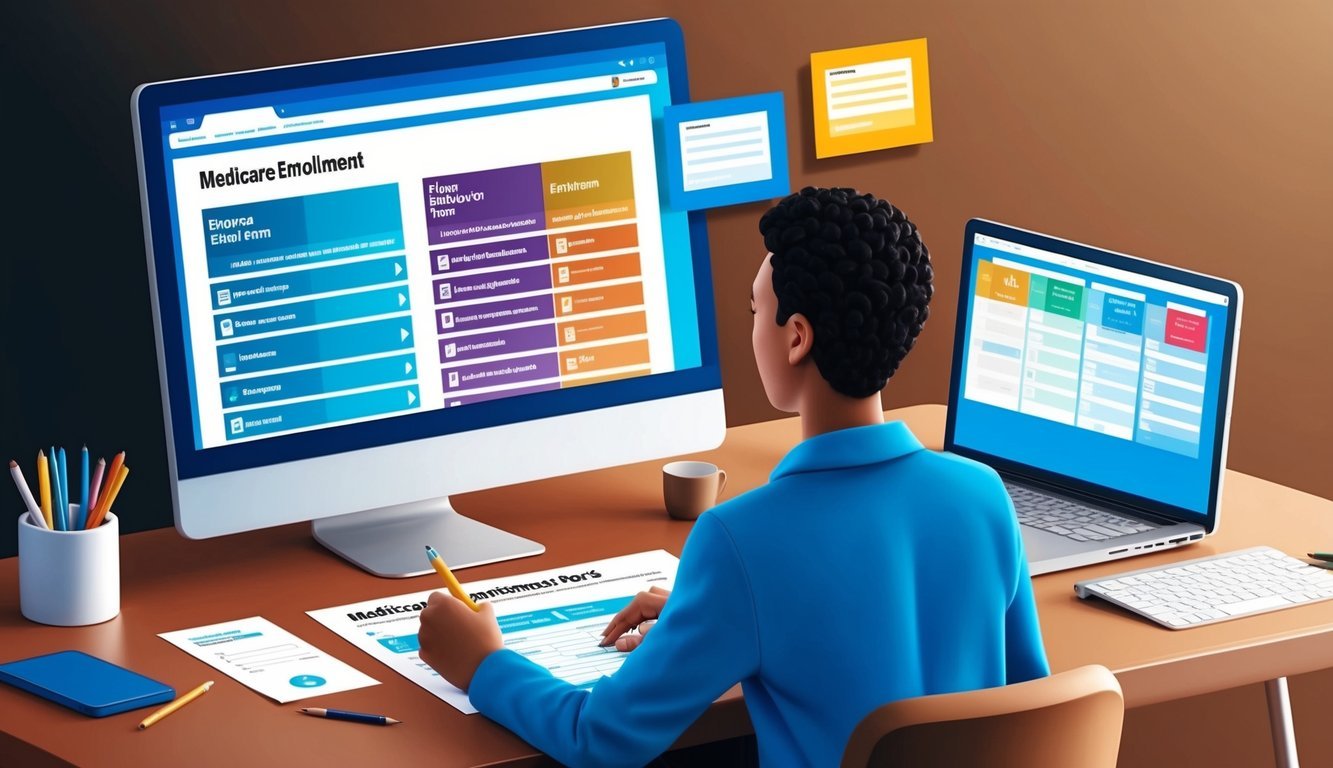“`xml
Thinking about signing up for Medicare in Ohio? You’re in the right spot! It can seem a bit confusing at first, but really, it’s not that hard once you break it down.
Here in Ohio, you’ve got a few options for enrolling in this essential health insurance program designed for seniors and some disabled individuals.

You can sign up for Medicare online at the Social Security Administration’s website.
It’s quick and simple! If you’re scratching your head about how to get started, the site has all the details you need.
Just have some personal info, like your Social Security number and employment history, ready to go.
After you fill out the application, you can track it online and get a confirmation when you’re all set.
If you’d rather chat with someone, you can call or visit your local Social Security office.
They’re there to help you understand your eligibility and guide you through the process.
Just a heads up: timing is everything with Medicare.
Make sure to sign up during your initial enrollment period to avoid any late penalties.
This period kicks off three months before your 65th birthday and ends three months after.
Trust me, you don’t want to miss it!
Don’t delay—getting your Medicare coverage set up early is key to ensuring you’re protected when you need it the most.
Key Takeaways
- You can enroll in Medicare online, by phone, or in-person at your local Social Security office.
- The initial enrollment window is seven months long, surrounding your 65th birthday.
- Medicare offers health insurance coverage for seniors and some disabled individuals in Ohio.
Getting Started with Medicare in Ohio

Figuring out Medicare can be like piecing together a puzzle.
You need to know the different parts, when to sign up, and how to make it all work.
Let’s break it down together.
Understanding the Basics of Medicare
Medicare is health insurance primarily for folks 65 and older.
It’s divided into different parts: Part A covers hospital stays, and Part B takes care of doctor visits and outpatient care.
You can sign up for Parts A and B whenever you’re ready.
Then there’s Part C, known as Medicare Advantage, which comes from private companies, and Part D, which handles prescription drugs.
Original Medicare? That just refers to Parts A and B working together.
Think of Medicare like a well-organized toolbox.
Each part has a purpose, and you get to choose the tools you need for your health.
Determining Your Eligibility
Most people qualify for Medicare when they turn 65.
But hey, if you have certain health issues, you might be eligible earlier.
To get enrolled, you’ll need to be a U.S. citizen or a legal resident for at least five years.
If you’ve been working and paying Medicare taxes for a decade or so, Part A will be free for you!
Some folks get Medicare automatically, especially if you’re already collecting Social Security benefits.
If that’s the case, you’ll be enrolled automatically when you hit 65.
Key Enrollment Periods
Timing’s everything with Medicare.
Your Initial Enrollment Period begins three months before your 65th birthday and lasts for seven months total.
This is your golden window to sign up without any penalties.
If you miss it, don’t panic! You can enroll during the General Enrollment Period, which runs from January 1 to March 31 each year.
Just keep in mind—you might face some late fees.
And if you’re still working past 65 and have job-based health insurance, there’s a Special Enrollment Period where you can sign up without penalties within eight months of losing that coverage.
Enrollment Process and Plan Selection

Getting signed up for Medicare in Ohio means making some key decisions about your coverage.
You’ll want to choose from different plans and understand when to enroll.
How to Sign Up for Original Medicare
You can sign up for Medicare when you reach 65.
The steps are pretty straightforward.
Just contact Social Security to enroll in Parts A and B—online, over the phone, or at your local office.
If you’re already receiving Social Security benefits, you’ll be automatically enrolled, and your Medicare card will arrive in the mail.
If you’re still working at 65, you might want to hold off on Part B enrollment.
Check in with your employer to know your options.
Remember—missing your Initial Enrollment Period could mean penalties down the line.
Mark those dates!
Choosing Between Medicare Advantage and Original Medicare
You’ve essentially got two options: stick with Original Medicare or opt for a Medicare Advantage plan.
Original Medicare comprises Part A (hospital coverage) and Part B (medical coverage), and it’s run by the government.
On the flip side, Medicare Advantage plans come from private companies and often bundle Parts A, B, and D (drug coverage).
Some of these plans even throw in extras like dental or vision care.
When making your choice, consider your health needs, budget, and which doctors you want to see.
Original Medicare lets you visit any doctor who accepts Medicare, while Medicare Advantage plans usually have set networks.
Also, don’t forget to compare costs! Look at premiums, deductibles, and out-of-pocket limits.
Prescription Drug Coverage with Medicare Part D
Part D is where you’ll find your prescription drug coverage.
You can get it as a standalone plan if you’re sticking with Original Medicare, or as part of a Medicare Advantage plan.
When picking a Part D plan, make sure to check the formulary—that’s just a fancy term for the list of covered drugs.
You want to be sure your medications are included!
And don’t overlook the pharmacy network.
Certain plans offer lower costs if you use preferred pharmacies.
Just a quick heads-up: be aware of the coverage gap, often called the “donut hole.” This refers to a temporary limit on what the plan will pay for your drugs.
You can join a Medicare drug plan during your Initial Enrollment Period or the annual Open Enrollment Period.
Additional Coverage Options
If you think you might need even more coverage beyond Original Medicare, consider Medigap policies.
They’re designed to help cover out-of-pocket costs like copayments and deductibles.
In Ohio, you’ve got a variety of Medigap options.
These plans are standardized, meaning the benefits stay the same regardless of which insurance company you choose.
Plus, during your Medigap Open Enrollment Period, which begins when you’re 65 and enrolled in Part B, you have a guaranteed right to buy a Medigap policy.
Some plans even throw in additional perks like fitness programs or discounts on hearing aids.
Take the time to compare and find what fits you best.
Just keep in mind: you can’t have both a Medicare Advantage plan and a Medigap policy.
Choose the option that works best for your health and finances.
Frequently Asked Questions
Getting into Medicare can feel a little daunting.
Let’s highlight the key steps and important info to make it easier.
How do I begin the Medicare enrollment process?
Start by checking if you’re eligible for Medicare.
Most folks can sign up when they hit 65.
If you’re already receiving Social Security, you might be automatically signed up.
If not, reach out to Social Security to kickstart the process.
What’s the deal with Medicare Part A sign-up only?
Some people only need Part A, which covers hospital stays.
If you’re still working and have solid insurance, it might make sense to delay Part B for now.
Part A is usually free if you’ve paid Medicare taxes long enough.
When should folks still working consider enrolling in Medicare?
If you’re still on the job after 65, you might not need Medicare just yet.
But it’s a good idea to consult your HR department.
Sometimes, Medicare can help fill in gaps in your work insurance, and you definitely want to avoid any late fees later.
What papers do I gotta have ready to apply for Medicare?
You’ll need your Social Security card and birth certificate—and don’t forget your tax info and work history.
If you’re not a U.S. citizen, grab your immigration documents too.
It’s better to be over-prepared than under-prepared when applying!
Is my local Social Security office the go-to spot for Medicare application?
Absolutely! Your local Social Security office is your best bet.
You can also find Medicare info for Ohio online.
But if you’ve got questions, chatting face-to-face might give you that extra clarity you need.
How long’s the wait to get the thumbs up for Medicare around Ohio?
Typically, it takes a few weeks to hear back after your application.
If a month passes and you haven’t gotten anything, don’t hesitate to give them a call.
They’ll fill you in on the status of your application.
“`

